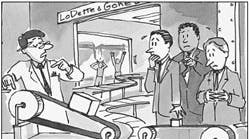Problem 176 — You don’t always need a new slant to convey your meaning, as this month’s problem by Ray Santillan Jr. of Euless, Texas, demonstrates.
The production staff at Lodette & Gohe, suppliers to the world-famous Lee Key Hydraulic Co., were in a frazzle. A major shipment was overdue, and one of the machinists had just announced that the conveyors that feed parts into the assembly line were out of synch.
“That’s OK, I’ve just solved our problem,” announced supervisor Mortimer Tipitt. “All we do is incline Conveyor 1 by 15 deg. I’ve also taken the liberty of making the large wheel the driver — my own idea!”
“But then the parts will slide,” stammered a voice in the back.
“Nonsense! Don’t you think I consider things like that?” retorted Tipitt.
Lee Key’s latest order is a component assembled from two flat parts that enter the assembly line on separate conveyors. Part 1 weighs 6 lb and is fed from Conveyor 1, and the 2.5-lb Part 2 comes in on Conveyor 2. Both parts are placed simultaneously on the conveyors and must arrive simultaneously at the assembley line. Conveyor 1 measures 120 in. from large-wheel centerpoint to small-wheel centerpoint. Driver wheel speed is 10 rpm, and, as Tipitt designated, the large wheel is the driver. Conveyor 2 measures 150 in. from centerpoint to centerpoint, and driver wheel speed is 20 rpm. Here, the small wheel is the driver.
The coefficient of friction between part and belt for both conveyors is 0.41. For both conveyors, the radius of the large wheel is 15 in., and the small wheel has a 7.5-in. radius. Parts travel one at a time on each conveyor. Assume no belt slip between drive wheels and belt.
Will Tipitt’s modification work? Will both parts now arrive at the assembly line at the same time?
Send your answer to:
Fun With Fundamentals
POWER TRANSMISSION DESIGN
1100 Superior Ave.
Cleveland, OH 44114-2543
Technical consultant, Jack Couillard, Menasha, Wis.
Solution to last month’s problem 175 — You are an individual of great vision, if you answered 50%. Here’s the twist.
Since the corners of the small square touch the circle, Figure 1, we can rotate the square a quarter turn, Figure 2,. It is apparent that the corners touch not only the circle but the sides of the large square. In other words the diagonal of the small square equals the side of the large square.
Let x = side of small square, in.
Using the formula for a right triangle,
2x2 = (6.25)2, or 39.06 in. 2
x = 4.41 in.
The area of the small square is x2 or 19.4. The area of the large square is (6.25)2, or 39.06. Divide the small square’s area by the large square’s to see that it is 50% smaller.

